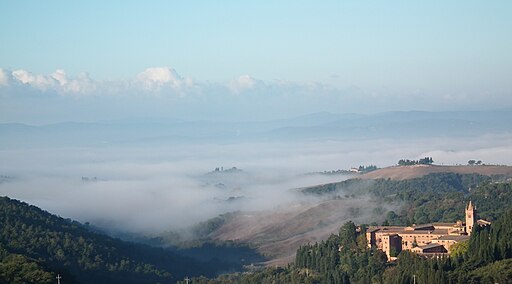| |
|
 |
 |

|
| N L E N G I T |
Castle San Giovanni d'Asso, seen from South[1]
|
|
![Toacana ] Galleria di immagini](../../titels/albump.gif) |
|
| |
 |
|
|
| |
|
The Crete Senesi | The Castle of San Giovanni d’Asso, seen from South, Crete Senesi
|
|
|
|
| |
|
San Giovanni d'Asso is a comune in the area known as the Crete Senesi, in the heart of the white truffle territory. The hamlet is overlooked by a large Castle which dates back to the Sixteenth century.
Location43° 09′ 10.1″ N, 11° 35′ 23.13″ E 
|
|
|
|
| |
|
|
Mappa San Giovanni d'Asso | Ingrandire mappa
|
The comune San Giovanni d'Asso includes the hamlets of Montisi, Lucignano d'Asso, Monterongriffoli, Vergelle and Pieve a Salti.
From January 1,2017 the municipalities of San Giovanni d'Asso and Montalcino were united into one comune. San Giovanni d'Asso is now part of a larger comune, Montalcino.
|
|
|
#poderesantapia Monte Amiata, vista da San Giovanni d'Asso, bellissimo panorama
|
| |
|
|
|
|
|
|
| |
|

Comune San Giovanni d'Asso | Official website
Traveling in Tuscany | Collegium Vocale Crete Senesi
J. Cassar, M.G. Winter, B.R. Marker, N.R.G. Walton, D.C. Entwisle, E.N. Bromhead, J.W.N. Smith, Geological Society of London, 30 apr. 2014, Stone in Historic Buildings: Characterization and Performance | books.google.be/books
Tuscan architecture: the stones through the centuries
Starting from the Etruscan - Roman period, archaeological evidence indicates the use of strictly IocaI building materials Iike the calcarenites along the Tyrrhenian coast (Pisa and Populonia) and in Volterra, while, on the foothilIs of the Apennines, the Etruscan Fiesoie and Cortona are characterized by the use of a quartz-feldspar sandstone (Pietra Serena), clearly visible in the large blocks of the city walls.
In the Middle Ages, the materials used were still local. Pisa and Lucca are characterized mainly by the use of the quartzites of Monte Pisano, Massa Marittima (the old Massa Metallorum) by travertine, and Siena and San Gimignano by a vacuolar limestone (Calcare Cavernoso) and later on by bricks. The cities in the foothills of the Apennines, such as Arezzo, Cortona and Pistoia, were still characterized by the Pietra Serena, while Florence was built from another kind of sandstone, Pietraforte. However, Prato, which is between Florence and Pistoia, was built using the local marly limestone, known as Alberese. [p 71]
|

|
|
|
 |
|
 |
|
|
Crete Senesi presso Asciano
|
|
Monte Oliveto Maggiore |
|
Monte Oliveto Maggiore, Campanile]
|
 |
|
 |
|
 |
| Crete Senesi, balle di fieno |
|
Pieve di Santo Stefano a Cennano. Absidi
|
|
Chiusure and the Campanile of Santa Maria di Monte Oliveto Maggiore
|
| |
|
|
|
|


Hidden secrets in Tuscany | Holiday house Podere Santa Pia
|
 |

[1] Photo by LigaDue, licensed under the Creative Commons Attribution-Share Alike 4.0 International license.
|
|
|
| |
|
|
|
| |
|
|
|
| |
|
|
|
| |
|
|
|
| |
|
|
|
| |
|
|
|
|